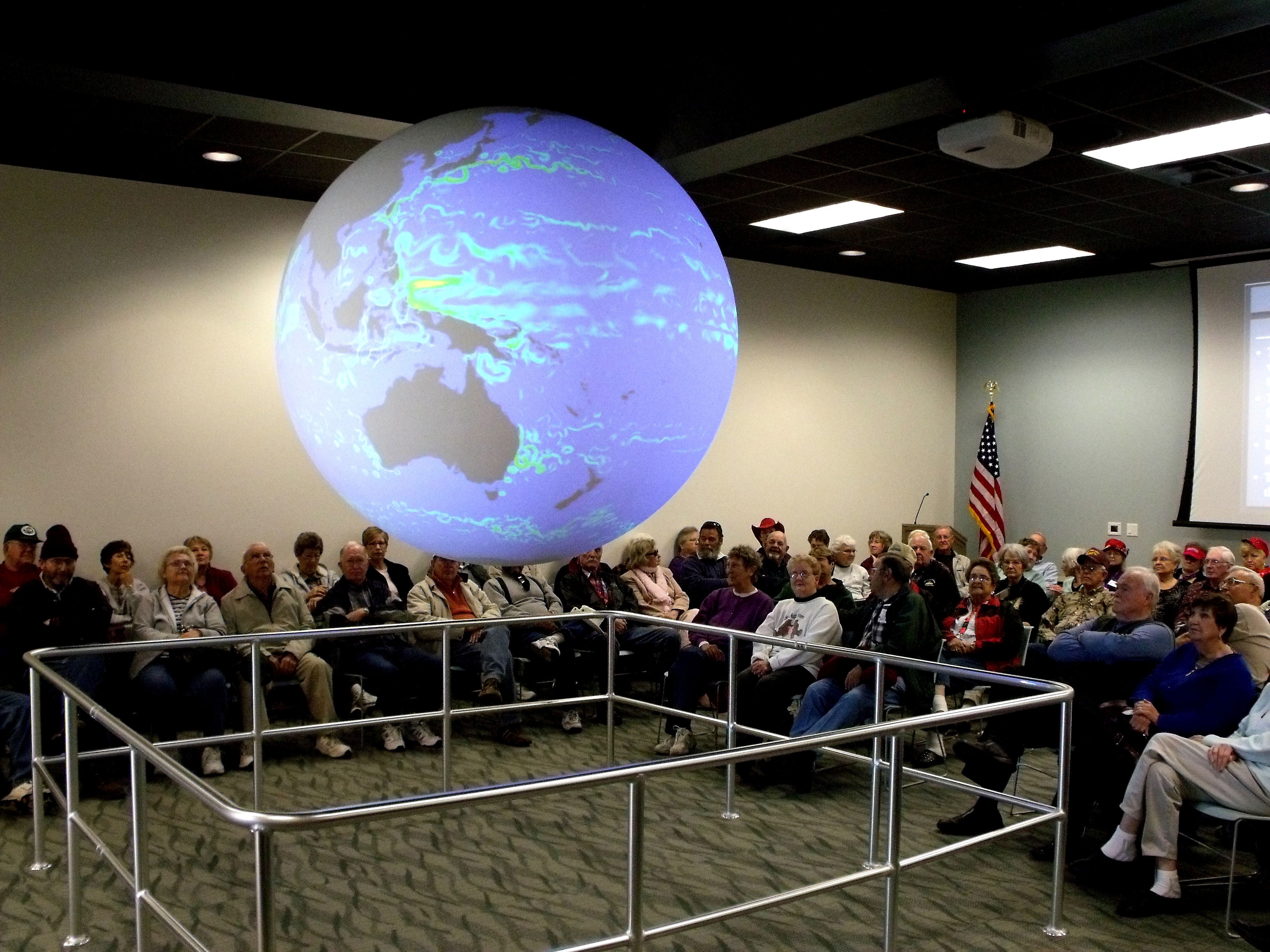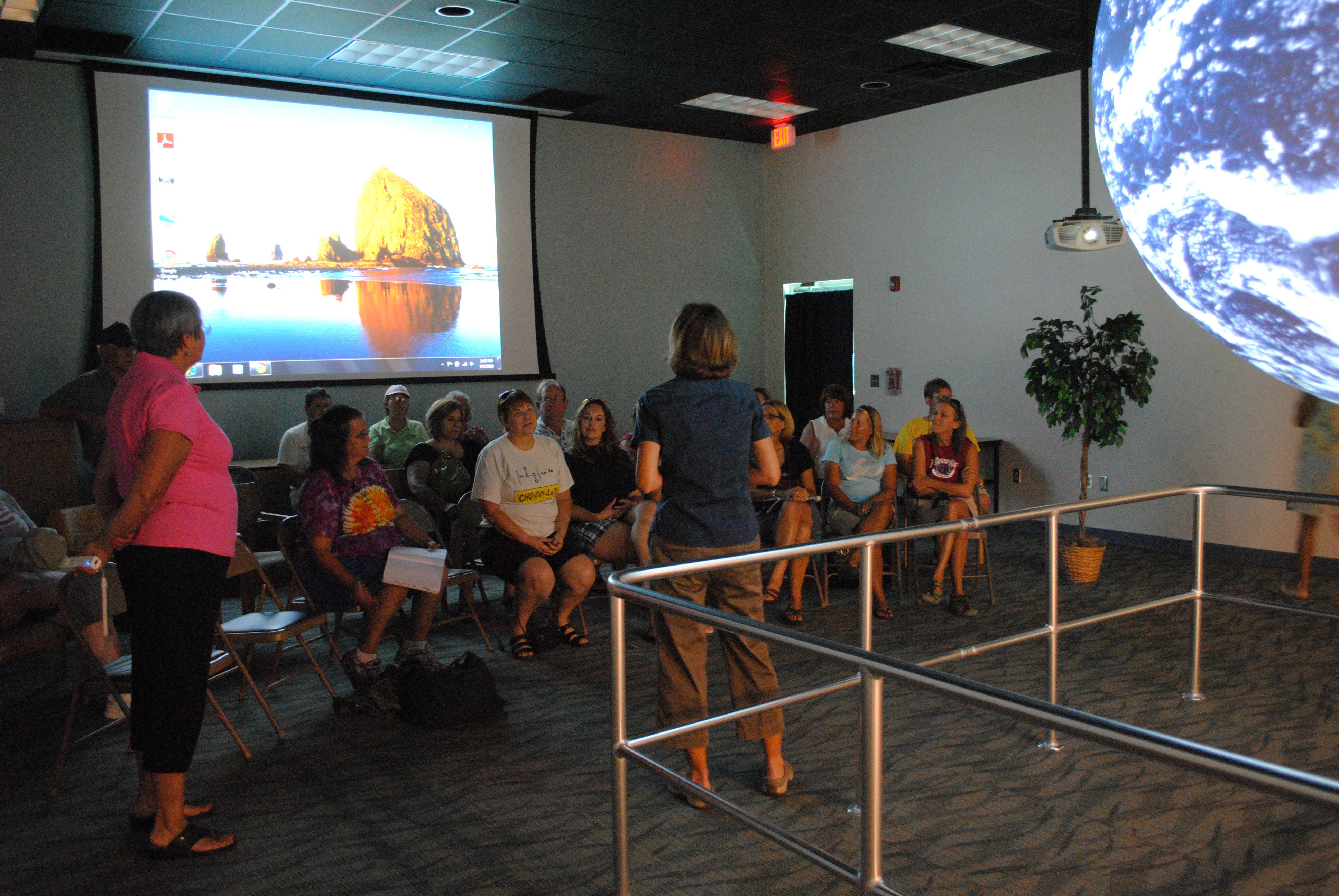All the world’s a stage – literally – as oceanic, atmospheric, and geologic conditions and events come to life on a “revolving” globe.

General public visitors attend a Science on a Sphere presentation at the Bay Education Center. (Photo by Jackie Hattenbach)
Researchers and science educators are using visualizations of oil spills, tsunamis, and hurricanes combined with science-based narratives to demonstrate the complex connectivity among Earth systems. The animated presentation of science in a world-wide context may grow public support for and inspire students to pursue interdisciplinary research that aims to improve response to future events.
With support from a Gulf of Mexico Research Initiative (GOMRI) award, the Dispersion Research on Oil: Physics and Plankton Studies (DROPPS) consortium led by Dr. Edward Buskey with the University of Texas Marine Science Institute (UTMSI) has partnered with the UTMSI Bay Education Center to incorporate up-to-date oil-spill and ocean research with the NOAA Science on a Sphere exhibit in order to reach a broad public audience.

K-12 educators learn about the teaching potential of Science on a Sphere at a professional development workshop. (Photo by John Williams)
“Science on a Sphere can take this large, abstract phenomenon and make it accessible. The large format, global view really enables you to get a sense of the scale and movement of the Deepwater Horizon spill in a way that is much more intuitive than looking at a two-dimensional map or even a series of maps,” explains Dr. Deana Erdner a UTMSI Associate Professor and DROPPS outreach coordinator. “In addition, the Sphere is beautiful – it really draws people in, which means that we can get the information and the ideas out to far more people than we could with a static display.”
The DROPPS outreach team is in the initial development stage of preparing narratives using cutting-edge ocean surface currents and temperature science. As they more fully develop these narratives, they will pair them with NOAA and NASA datasets to create a powerful audio-visual teaching resource. The animation below is an example of how NOAA satellite data are used to show the daily movement of surface oil from the Deepwater Horizon incident from April 23 to August 2, 2010 and the locations affected.
(Above) Science on a Sphere Oil Spill Animation. Note: No audio. (Credit: NOAA)
DROPPS is pursuing collaboration with other GoMRI-funded consortia to incorporate new datasets into future Science on a Sphere presentations.
Last year, over 1,000 K-12 school children and 10,000 members of the general public attended UTMSI Science on a Sphere presentations. There are 82 exhibits around the world; 53 of them in the United States. All exhibits will have access to the science narratives that DROPPS is developing using the NOAA Deepwater Horizon dataset. This collaborative effort extends the availability of DROPPS outreach to a world-wide audience.

Children from Sea Camp attend a Science on a Sphere program at the Bay Education Center. (Photo by Carolyn Rose)
In addition to the exhibit presentations, the DROPPS outreach team incorporates oil-spill research in teacher workshops and when speaking to visiting K-12 groups. A middle school biology teacher who attended a presentation said, “The globe is awesome. I think students are really going to enjoy that. I’m looking forward to as many away-from-school and out-of-the-box learning situations that I can find.”
The DROPPS program includes six research institutions in five U.S. states and Norway. Scientists are investigating and modeling key processes involved with the dispersion of oil spills, interactions of oil with marine organisms and bacteria, and the environmental impact of these interactions. The experimental and numerical studies are performed at varying scales and levels of complexity, from bench-top studies to characterize specific phenomena to meso-scale experiments that are essential for mimicking realistic physical and biological conditions. The overall goals of these studies are to understand the fate of oil in the Gulf of Mexico; to provide data sets/predictive models to assess the environmental impact; and, via profiling of toxic compounds related to oil spills, to assess public health implications of oil spills in the Gulf.
This research is made possible by a grant from BP/The Gulf of Mexico Research Initiative. The GoMRI is a 10-year, $500 million independent research program established by an agreement between BP and the Gulf of Mexico Alliance to study the effects of the Deepwater Horizon incident and the potential associated impact of this and similar incidents on the environment and public health.
